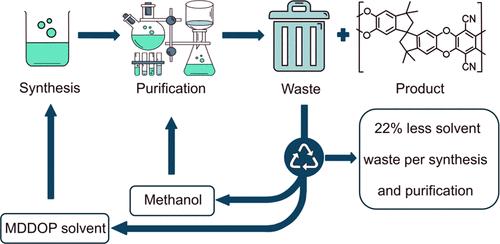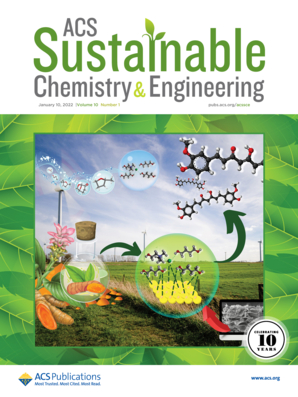Greener Synthesis of the Polymer of Intrinsic Microporosity PIM-1 for Gas Separation
IF 7.1
1区 化学
Q1 CHEMISTRY, MULTIDISCIPLINARY
引用次数: 0
Abstract
Polymers of intrinsic microporosity (PIMs) are studied as membranes for energy-efficient and environmentally friendly separation technologies, but greener polymerization methods are desirable for further scale up. This work aimed to synthesize the prototypical PIM (PIM-1) via a greener synthetic route by changing the solvent system to methyl-5-(dimethylamino)-2,2-dimethyl-5-oxopentanoate (MDDOP), a structural analogue of the green solvent Rhodiasolv PolarClean. Mass-based green metrics analysis was performed on MDDOP, determining atom economy, complete environmental factor, and total carbon intensity, comparing each to synthetic routes to PolarClean. Green metrics analysis found MDDOP synthesis produced less waste than PolarClean. MDDOP solvent capabilities were exemplified via PIM-1 polymerizations using 5,5′,6,6′-tetrahydroxy-3,3,3′,3′-tetramethyl-1,1′-spirobisindane (TTSBI) with either tetrafluoroterephthalonitrile (TFTPN) or tetrachloroterephthalonitrile (TCTPN), varying the temperature (120–160 °C) and reaction duration (50 min–6 h). Recovery of methanol and MDDOP post PIM-1 synthesis reduced solvent waste by 22%. Reactions using TCTPN produced polymers with higher molar masses than those produced using TFTPN. All samples showed varied topology, with evidence of branching and colloidal network. The polymer from the most successful reaction conditions (TCTPN, T = 140 °C, 6 h) was fabricated into thick film membranes and tested with pure gases for CO2/CH4 and CO2/N2 gas pairs, performing comparably with PIM-1 synthesized using conventional solvent systems.

本征微孔PIM-1气体分离聚合物的绿色合成
本征微孔聚合物(PIMs)作为膜被研究用于节能环保分离技术,但更绿色的聚合方法是进一步扩大规模所需要的。本工作旨在通过更环保的合成途径合成PIM原型(PIM-1),将溶剂体系改为甲基-5-(二甲氨基)-2,2-二甲基-5-氧戊酸酯(MDDOP),这是一种绿色溶剂Rhodiasolv PolarClean的结构类似物。对MDDOP进行了基于质量的绿色指标分析,确定了原子经济性、完整环境因子和总碳强度,并将每个合成路线与PolarClean进行了比较。绿色指标分析发现,MDDOP合成产生的废物比PolarClean少。采用5,5 ',6,6 ' -四羟基-3,3,3 ',3 ' -四甲基-1,1 ' -旋苯丁烷(TTSBI)与四氟对苯二甲酸(TFTPN)或四氯对苯二甲酸(TCTPN),在不同温度(120-160°C)和反应时间(50 min-6 h)下进行PIM-1聚合,考察了MDDOP的溶剂性能。PIM-1合成后甲醇和MDDOP的回收减少了22%的溶剂浪费。使用TFTPN反应产生的聚合物比使用TFTPN反应产生的聚合物具有更高的摩尔质量。所有样品都显示出不同的拓扑结构,有分支和胶体网络的证据。在最成功的反应条件下(TCTPN, T = 140°C, 6 h)将聚合物制备成厚膜膜,并在纯气体中测试CO2/CH4和CO2/N2气体对,其性能与传统溶剂体系合成的PIM-1相当。
本文章由计算机程序翻译,如有差异,请以英文原文为准。
求助全文
约1分钟内获得全文
求助全文
来源期刊

ACS Sustainable Chemistry & Engineering
CHEMISTRY, MULTIDISCIPLINARY-ENGINEERING, CHEMICAL
CiteScore
13.80
自引率
4.80%
发文量
1470
审稿时长
1.7 months
期刊介绍:
ACS Sustainable Chemistry & Engineering is a prestigious weekly peer-reviewed scientific journal published by the American Chemical Society. Dedicated to advancing the principles of green chemistry and green engineering, it covers a wide array of research topics including green chemistry, green engineering, biomass, alternative energy, and life cycle assessment.
The journal welcomes submissions in various formats, including Letters, Articles, Features, and Perspectives (Reviews), that address the challenges of sustainability in the chemical enterprise and contribute to the advancement of sustainable practices. Join us in shaping the future of sustainable chemistry and engineering.
 求助内容:
求助内容: 应助结果提醒方式:
应助结果提醒方式:


